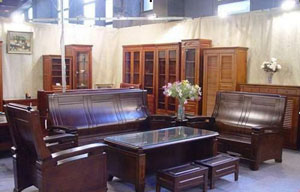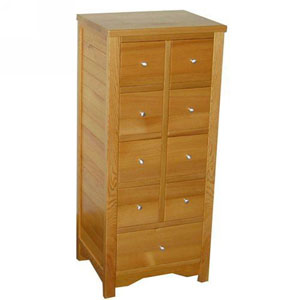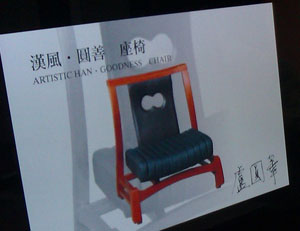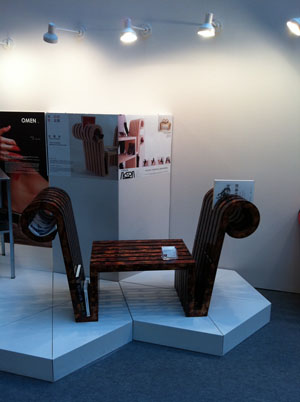High-quality Furniture from Taiwan Features Fine Materials and Workmanship
Manufacturers respond to the shrinkage of the furniture industry by seeking innovation and added value
2012/10/11 | By Michelle Hsu

With the soaring cost of raw materials and labor, some domestic market-oriented manufacturers have followed the example of their export-oriented counterparts by setting up factories overseas, shipping their furniture back to Taiwan and diversifying their product lines in pursuit of a sustainable business model.
Black Sandalwood Chair
Yamu Furniture provides a prime example of this type of development. Established around 40 years ago, Yamu initially focused on making traditional Taiwanese wood chairs; later on it built plants in Indonesia, using local materials and labor there to make furniture that was shipped back to Taiwan. It adopted a product-diversification strategy, teaming up with other partners to supply products made of other materials, such as western-style sofas, glass dining chairs, and iron furniture. When the company reached a certain size it renamed itself the Yamu Living Center and began offering a wide variety of small-quantity products. This, in general, reflects the trend of Taiwan's furniture industry today.
Yamu's wooden furniture falls roughly into three categories: products made locally with native Taiwanese wood, products made locally with imported wood, and products made of foreign raw materials overseas and shipped back to Taiwan. The company says that products in the first category are the most expensive, because Taiwan has banned logging for the purpose of making furniture and the high-quality wood used is very limited in quantity and very high in price.
Yamu's black sandalwood living-room chair is made of such valuable wood, which is strong and has an attractive texture that shimmers under a simple wax coat. The deep, unpresumptuous color perfectly fits the needs of sophisticated consumers.
To accentuate the natural beauty of black sandalwood, Yamu keeps ornamentation to a minimum. The chair's simple lines and meticulous workmanship highlight the simple elegance of the wood, and its smooth texture provides great comfort.
Taiwan Cypress Cabinet
Cypress is another of Taiwan's valuable woods. Manufacturers that used this wood once thrived in Taiwan, but most of them have gone out of business. One exception is Crown Furniture, founded in 1968; its survival, says manager Wen Chia-chi, is due to the loyalty of customers who purchase cypress furniture regularly, though in small quantities. Purchases of large quantities are, in fact, impossible because of the limited supply of the wood.
Wen notes that in earlier times only cypress trees that were over a thousand years old were used to make furniture, but that later on younger trees—300 or 400 years old—came to be used. Today, most cypress furniture is made of driftwood or wood reclaimed from old furniture or buildings. Cypress retains its distinctive, pleasant aroma even after repeated use.
Around six species of cypress grow in Japan, Taiwan, and eastern and western North America. Taiwan is at the southernmost fringe of the trees' distribution, and is the only place in tropical Asia where they grow. Taiwan has two species, meihili (red cypress) and hinoki cypress, the former of which is found nowhere else. In Taiwan the trees grow in high, mist-shrouded mountains, giving them their unique texture.
Alishan, in the central county of Chiayi, is one of the island's major cypress-growing areas; and Crown Furniture has, in the past, been able to use its convenient location in Chiayi City to obtain supplies of fine cypress. Things are different today; the wood is so precious that, instead of cutting it into pieces, manufacturers try to finish its surface only slightly, leaving cracks and spots that emphasize its natural beauty.
Wen points out that cypress resists moisture and is thus ideal for Taiwan's humid environment. To assure quality, Crown Furniture uses senior carpenters—60 to 70 years of age—to make its cypress cabinets; employing traditional methods, they make sure that the wood is joined seamlessly and that the drawers can be opened and closed with ease. The beauty of the cabinets, both inside and outside, make them outstanding pieces of craftsmanship.
The manager explains that the cabinets are made using the complicated mortise-and-tenon joinery technique, providing a sturdy structure that adds stability and durability.
Traditional Chinese “Genial Chair”
Lu Yuan-hua, a prominent furniture designer (he has won several awards for his designs) and chairman of the Taiwan Furniture Properties Association (TFPA), is a master of the mortise-and-tenon method.

Lu subscribes to the “fine materials, great workmanship” philosophy described in the the Zhouli (“Rites of Zhou”), a book of the 2nd century BC, and likes to use padauk wood because of its toughness, smooth texture, and fine patterns. His earlier works include the “Tufu Chair” and “Taochian Chair,” which manifest the simple styling of the Ming Dynasty; both are square in shape, symbolizing the frankness and integrity of the ancient Chinese literati. The chairs have a smooth curvature and precise proportions that add softness to their masculine shape.
Later works, such as the “Genial Chair,” shows a traditional Chinese styling with simple shape that is less bold and more modest compared with the earlier chairs.
“Wealth Chair”
With the shrinkage of Taiwan's furniture industry, manufacturers are now turning to innovation and added value in their products. The resulting surge in demand for designers has helped prompt universities to add industrial design programs to their curricula.

One of the results of this emphasis is the “Wealth Chair,” designed by Yi Yu-an and Lee Chi-hung, who graduated from the University of Arts last year. The chair features a lacquered finish, which is seen only in Chinese and Japanese utensils; in China lacquer symbolizes auspiciousness, and in Japan it stands for simple elegance.
Before the lacquer is applied, the chair is sprinkled with gold-colored powder to impart a look of glamour and good fortune; hence the name, “Wealth Chair.” Its “ancient Chinese propitious cloud” concept is mated with modern geometric shapes, giving it a contemporary appearance.
Although simple in appearance, the chair has a highly sophisticated structural design; it is made up of parts that can be stacked to form a magazine rack, and the seat and armrest can be used for placing magazines and newspapers. When used as a single unit, it can be sat upon and a book table can be pulled out from the armrest. The chair presents the creativity of Taiwan's new generation of designers.




